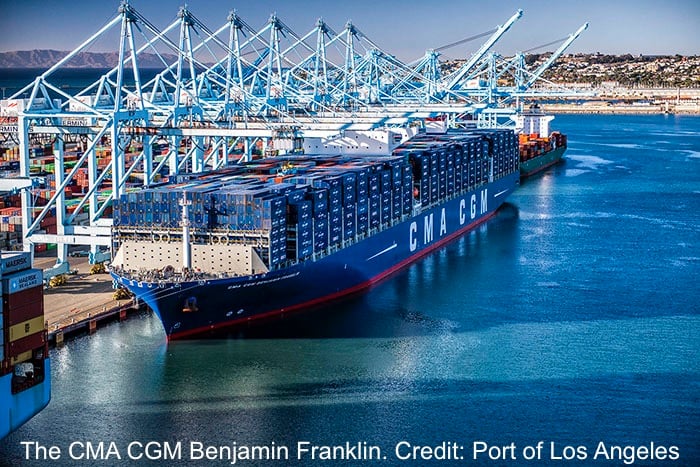New Year, Same Old Port Congestion
 It just seems inescapable for shippers. There’s no way to avoid hearing the “C” word. The “C” word being, of course, congestion.
It just seems inescapable for shippers. There’s no way to avoid hearing the “C” word. The “C” word being, of course, congestion.
Although congestion has certainly been an issue at ports throughout the country, especially on the West Coast, our focus in today’s blog is on the Ports of Los Angeles and Long Beach, by far the nation’s busiest ports.
Congestion really became a big issue at the Ports of Los Angeles and Long Beach back in 2014, when bigger ships, carrier alliances, chassis shortages, truck driver shortages, and rail issues combined to significantly increase the amount of time it took trucks to get into the ports, drop off and pick up shipping containers, and get out.
Then congestion got much, much worse toward the end of 2014 when the International Longshore & Warehouse Union (ILWU) orchestrated work slowdowns to gain leverage in their contentious contract negotiations with the Pacific Maritime Association (PMA), which countered with mini lockouts.
Congestion did not suddenly get cleared when an agreement was finally reached between the ILWU and PMA, although shippers were intensely watching for resolution to the problem, since the congestion had already been so costly for both importers and exporters.
Just by looking at our list of the top 11 international shipping blogs of 2015, you can easily see how big an issue congestion has been with a blog about how long it will take to clear congestion at West Coast ports coming in at number 5 and several other blogs on the list relating to port congestion.
So how long will it take to end the congestion? Almost a year after the contract negotiations between the ILWU and PMA ended, it’s still a work in progress.
Shippers, looking at headlines about port congestion, are starting to feel like Detroit Lions fans. Whenever the Lions lose, the headlines start popping up: “Same Old Lions”. And let’s face it, the Lions have lost a lot. Now shippers look at headlines about the Ports of Los Angeles and Long Beach and see: “Same Old Congestion”. Let’s face it, we’ve been looking at a lot of congestion.
There is a big difference, however. Shippers are only a couple years into this congestion issue we’re having, while the Lions have not played in an NFL championship game in almost 60 years. Maybe the Ford family could afford to allow their team to lose for that long, but the nation certainly can’t afford this congestion problem to persist for 60 years. Even two years feels too long.
Serious progress has been made at the Ports of Los Angeles. The port complex seemed buried in shipping containers by the end of the labor negotiations, seriously hindering terminal operations. Now, terminal operations are reportedly back to normal. Yet there is still a major problem with trucks getting in, picking up shipping containers, and getting out.
Bill Mongelluzzo writes in an article published by the Journal of Commerce (JOC):
In-terminal fluidity is not the problem. During the depth of the port congestion earlier this year, terminals were overwhelmed with containers. Dockworkers had to move each container three or four times in order to retrieve the exact box that was designated for delivery to a trucker. Man-hours increased 20 to 30 percent due to this multiple handling of containers.
Numbers posted on the website of the Pacific Maritime Association show that man-hours this fall have returned to the levels they were at in the spring of 2014, before the ILWU labor issues began. This indicates that multiple handling of containers has been greatly reduced, yet in-terminal truck visit times remain elevated.
The article reports that truck turn times are stuck at the “unacceptable level” of around 90 minutes. It breaks that down into two numbers: average in-terminal times of 70 minutes and average queue times outside the gates of 20 minutes.
The average amount of time it takes for trucks to get in and out of the port complex has not been improving, leaving shippers to pay extra fees from the trucking companies picking up their cargo containers.
For comparison, before the increase of truck turn times starting in Spring of 2014, the standard truck turn time, including queue and in-terminal times, at the Ports of Los Angeles and Long Beach was 60 minutes. While it is much better than the hours of gridlock experienced during the contentious labor negotiations between the ILWU and PMA, a fifty percent increase from the standard hour to the current hour and a half, with no sign of returning to normal, is a major issue for truckers and shippers.
PierPass, the non-profit company created by the terminal operators at the Ports of Los Angeles and Long Beach to address issues like congestion, is trying to tell truckers they’re not waiting at the ports as long as they think they are.
According to another JOC article by Bill Mongelluzzo, PierPass claims in-terminal turn times for trucks at the 13 container terminals at the Ports of Los Angeles and Long Beach actually average 50 minutes rather than the 70 minute average the Harbor Trucking Association (HTA) reports with its truck mobility program that measures monthly trucker turn times.
Obviously, the ports and truckers don’t see eye to eye on the issue of trucker wait times.
A few of the argued issues brought up by the JOC article are whether or not to include time spent by truckers at “trouble windows” in turn time calculations, whose fault delays at “trouble windows” usually are, and whether time spent in queues outside the terminal should be counted in trucker turn times:
The terminals exclude time that truckers spend at the so-called trouble windows where problems such as inaccurate documentation and payment issues are handled. While trouble tickets account for a relatively small percentage of all transactions, individual visits that include a trip to the trouble window can last for three or more hours…
Terminals say trouble tickets are generated primarily by failures on the part of cargo interests and truckers. Trucking executives disagree. Fred Johring, president of Golden State Express and chairman of the HTA, said his company, like many, will not send a driver to the harbor unless notification is received that the shipment has cleared Customs and is ready to be delivered.
Truckers do, however, too frequently send drivers to the harbor only to find that there are not enough chassis available, that the terminals are unable to locate the containers or because a section of the facility is closed to trucks due to congestion, Johring said.
…
… Terminals would like the clock to begin ticking when the truck reaches the first portal at the terminal. Truckers believe turn times should be measured when truckers arrive in the queue outside the gates…
No matter how the time is measured, truck congestion at the Ports of Los Angeles and Long Beach is a major problem. Making it worse is the increasing size and regularity of megaships calling on the port complex.
If we continue our trend of looking at recent Bill Mongelluzzo articles in the JOC, an article posted the day after Christmas reported the arrival of the CMA CGM Benjamin Franklin, an 18,000 TEU container ship, at the Port of Los Angeles.
The article is all about how this huge ship’s arrival marks a new era of megaships in the U.S. that will add more stress on ports and the supply chain.
With the huge increase of shipping container density hitting ports, finding new ways to increase efficiency and shorten the trucker turn time at the Ports of Los Angeles and Long Beach (as well as the rest of the ports around the country) is imperative.
Unfortunately, the increase in shipping containers hitting ports all at once with the arrival of megaships also makes finding a solution more difficult. Shippers are likely to see more of those “C” word, “Same Old Congestion” headlines.
![]()
Source: UC Blog



